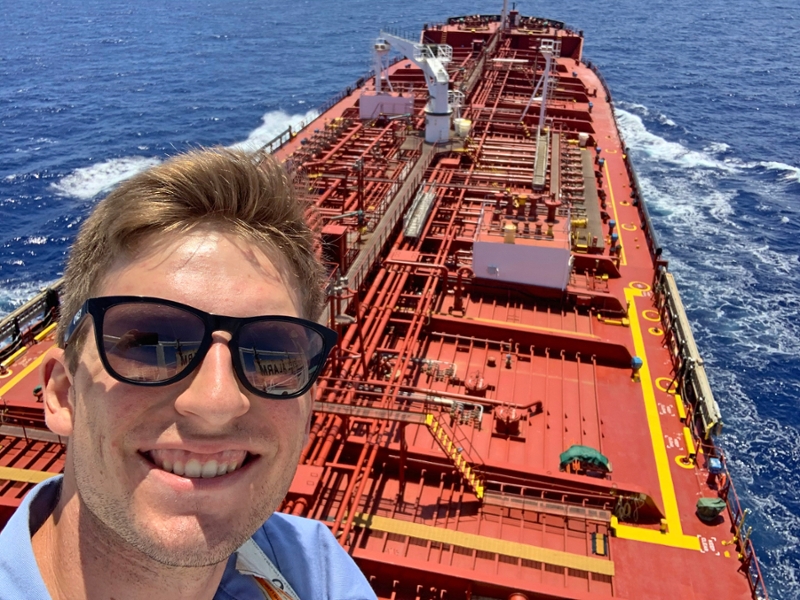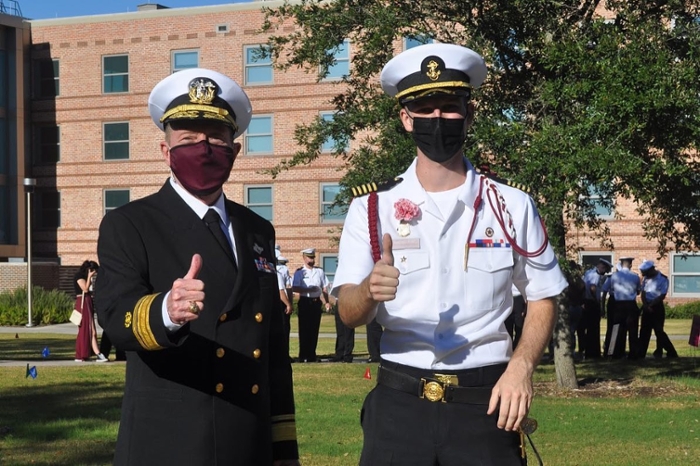Sailing Forth: Cole Masington '21
December 29, 2020
Tweet
By Andréa Bolt, Communications Specialist, Division of Marketing & Communications
Cole Masington ‘21 took it upon himself to obtain a vessel in order to capture video and photos of Kings Point cadets during their recent cruise aboard the borrowed T/S General Rudder.
Accompanied by fellow student and Texas A&M Maritime Academy Corps of Cadets Master at Arms Alexander Hankins, Masington was intent on building up the General Rudder’s image repository and ensuring his cadet colleagues at Kings Point had photos to remember their first training cruise in the Gulf of Mexico.
“The captain of the ship thought it was cool that we were out there taking photos of them as they returned, we had plenty of waves and smiles,” he said.
Such is the drive and demeanor of the Texas A&M Maritime Academy’s current Deputy Corps Commander, looking out for others and jumping at any opportunity to be on the water.

As a maritime transportation major, on the water is where Masington feels most at home. And after all of the craziness and uncertainty this year has brought, he’s ready to get back to a regular training schedule and cruises.
That said, the year certainly wasn’t a wash for him. Over the summer, Masington gained crucial maritime experience sailing on the crude oil and chemical tanker M/T Overseas Anacortes.
Masington sailed aboard the 601 foot-long vessel, which he said can hold approximately 13 million gallons of cargo for 75 days. The experience, he claims, was one for the books.
Masington worked as a crewmember and helped the vessel transport crude oil from Corpus Christi to Marcus Hook, Pennsylvania. The voyage measures out to just under 2,000 nautical miles and takes about two weeks to complete, round trip.
“The ship would take a direct route east southeast across the Gulf of Mexico, then head north past the Florida Keys and Cape Hatteras. Every night, a plethora of lights, buoys, beacons and other navigational aids lit up the surface of the water,” he said. “It was amazing to reference what was on the chart with the real thing. Each voyage was a great learning experience for me, full of terrestrial navigation, celestial navigation, deck maintenance, safety inspections, log books, passage planning, weather routing, and ship handling.”
It took him a minute to get into the swing of things, but once he found his sea legs, Masington felt just like another member of the crew, an honor he said he took to heart. There was no better feeling than being told by the captain, “You’re always welcome back on this ship,” Masington said.
“Seeing the horizon blocked by a massive vessel was a wake-up call, climbing up the towering pilot ladder was an exciting way to start off my first real-world, non-training ship experience. I could barely keep my eyes from wandering as I walked past manifolds, piping, the accommodation house, and a multitude of other equipment on deck. It’s a lot to take in,” he described.
Masington soaked up every experience he could, from anchoring, docking, line handling, cargo operations, stability calculations, tank cleaning and lots of coffee brewing, he said with a laugh.
“There were tough days, there were long days, but there was never a bad day. I truly put my best focus and effort into having the greatest experience I could. I came away knowing that this is what I want my career to be.”
Naturally, Masington is itching for more. Like many cadets, he has a soft spot for the General Rudder, but larger vessels like tankers offer many added learning opportunities compared to a training ship.
With the recent announcement of the forthcoming National Security Multi-Mission Vessel, Masington feels assured future cadets will benefit from the immense offerings of such a sizable, state of the art training platform.
Time is of the essence for the current aging training ship fleet, with some ships approaching 40 years of age and others being over 60 years old, Masington explained.
“A complete and technologically advanced training and education at Texas A&M Maritime Academy is key to serving in an industry that will grow the U.S. economy and make certain the U.S. Navy is properly staffed. The NSMV will accomplish just that. The stark comparison of a 525-foot NSMV with the 224-foot General Rudder is surreal.”
For one, the Texas A&M Maritime Academy will have the ability to sail as one unit, one crew, on our own ship, something we have not been able to do in a long while, Masington emphasized.
He feels TAMMA will finally be able to optimize its own curriculum, leadership structure and resources with such a ship.
“Sailing as one unit also allows our cadets to build ‘esprit de corps,’ something vital to the overall morale of the academy. It will be a sight to see a ship larger than the pier when driving across the Pelican Island Bridge. It won’t be long until maroon paint finds its way into every area of the ship,” he said with a knowing laugh.
Masington also said that with the NSMV future cadets will have access to a training platform that is up-to-date with the industry they have chosen to enter.
Cadets sailing aboard the NSMV have access to top-tier simulators, classrooms, practical labs, and workspaces that have never before been offered aboard a training ship.
“While theoretical learning is being happening below decks, the real thing is taking place on the bridge, in the engine room and out on the various working decks of the vessel. Even while shore side, the NSMV offers training capabilities that have never been accessible before. The arrival of the NSMV will be a critical turning point for Texas A&M Maritime Academy,” he stated.
Though for Masington, TAMMA cruises are swiftly coming to an end. When he graduates in August, freshly printed Third Mate license in hand, he’s headed for the commercial industry, hoping to work on tankers again.
He wants more experiences like that aboard the Anacortes and he feels his time at TAMMA has helped prepare him for these experiences, especially concerning his leadership roles in the Corps of Cadets.
“Promptness, respect, hard work, resilience, excellence, honesty, and maturity are all expected of new third mates when they embark their first ship. The Aggie Core Values are also integral to being a good mariner,” he explains. “Although leadership is not mandatory - it may not directly impact how good of a mariner you will become - it will strengthen management skills, cooperation amongst crew members, troubleshooting, and teamwork. These are all qualities of good leaders, both shore side and at sea. Mariners don’t have to rise to the level of master, but doing so will expose them to new leadership challenges, experiences, and every facet of how a vessel operates."
###
Media contact:Communications Specialist
a_bolt@tamug.edu
More:
Read more about Maritime Administration
Read more about Maritime Transportation
Read more about Texas A&M Maritime Academy
Read more about Student Life